An Authentic German Schnitzel Recipe For Delicious Results!
If you want to make a classic German meat dish, German Schnitzel is a great option!
Made from pork that is thinly pounded, this pork schnitzel recipe makes perfect golden brown schnitzel every time.
Garnished with a slice of lemon, pork schnitzel serves well with potato dishes like French fries or German potato salads!
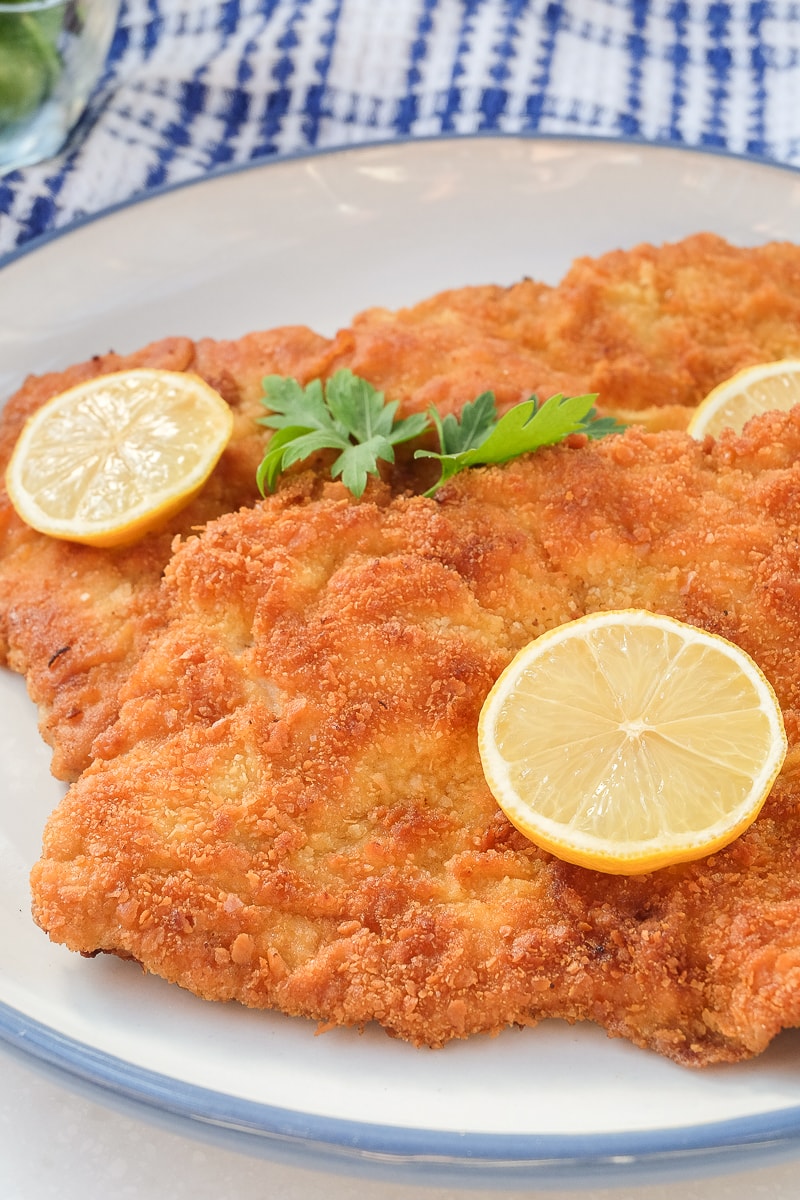
Recipe Tips & Substitutions
Just A Head’s Up: This is a recipe for German schnitzel, not Wiener schnitzel. German schnitzel is usually made from pork whereas true wiener schnitzel is the schnitzel made with veal.
However, the way they are prepared is pretty much the same so you can definitely use veal and still follow the step-by-step process outlined in the recipe card below!
To make perfect schnitzel, follow these recipe tips for best results:
When pounding the pork cutlet, be sure to use the flat side of the meat hammer. The pointed side is for tenderizing and this can damage the schnitzel and put holes in it!
Try to drip off as much egg wash as you can since the extra egg will make breading the schnitzel more difficult. Also, excess egg will cook strange in the frying pan and may ruin the delicious brown exterior!
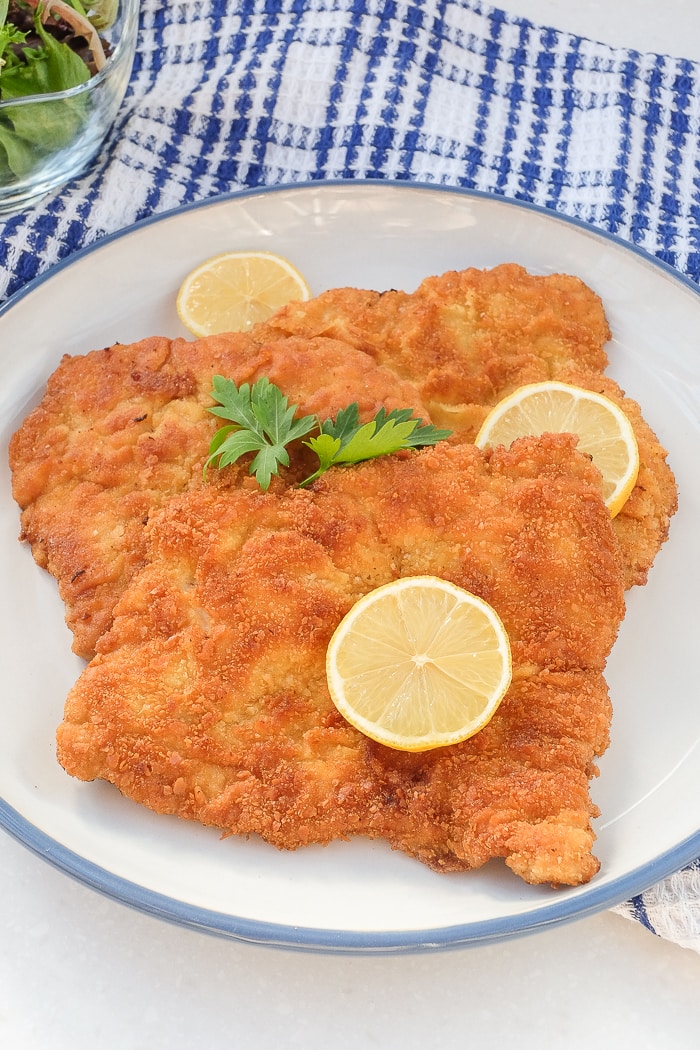
Make sure to use lard, shortening, or oil with a high smoke point (e.g. avocado oil) for frying. Butter burns far too quickly.
Having patience is important. Frying German schnitzel on low will help ensure you get an even brown crust and not overly burnt spots when cooking.
How to Make German Schnitzel – Step by Step Instructions
To make this classic schnitzel recipe at home, you can follow the recipe card at the bottom of this post with exact measurements and a full list of ingredients.
For those who want to see what each step looks like, follow the recipe process photos in this section.
This way, you can compare your schnitzel progress to how ours looked and gauge if you’re on the right track!
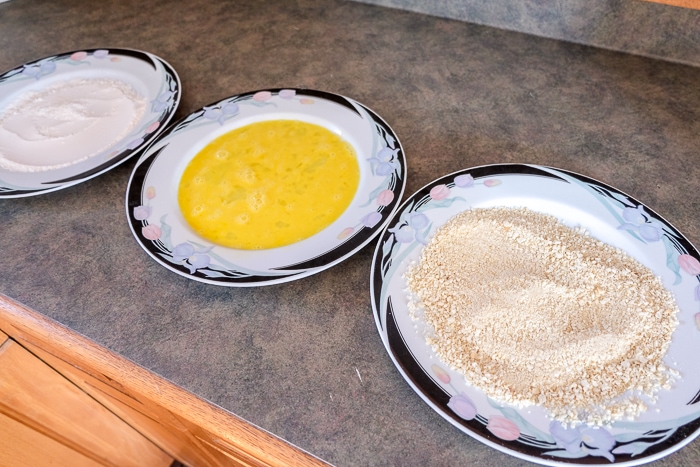
First, prepare your workstation by getting three large plates with a little bit of an edge.
Put the flour on the first plate. Crack the eggs and whisk them with a fork until uniform in color on the second plate. Lastly, add the breadcrumbs to the third plate.
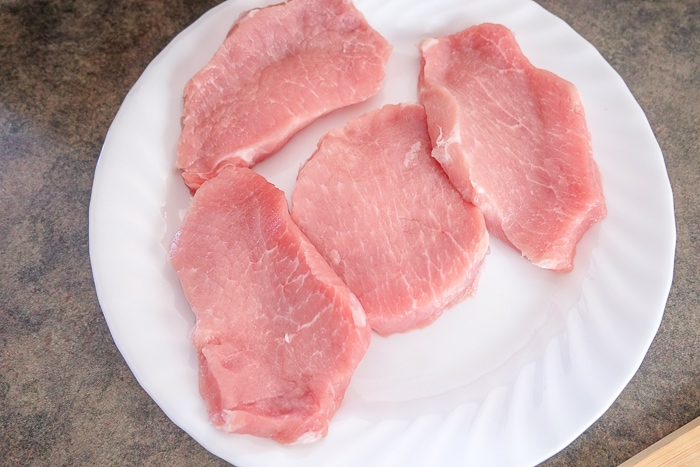
Trim the meat of any excess fat, if there is any.
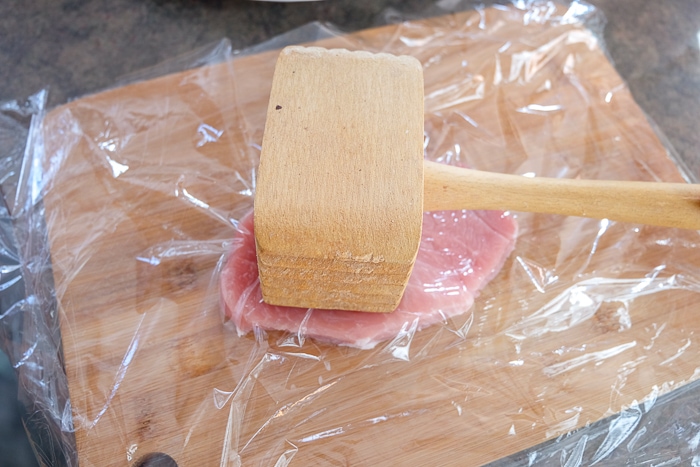
Place one pork chop between two pieces of cling wrap (or put it in a freezer bag) and pound it with the flat side of a meat hammer until thin.
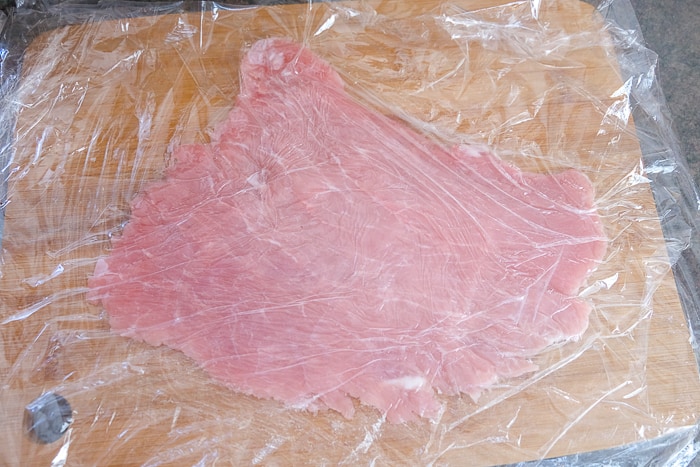
You’ll be surprised how large relatively small pieces of meat can get. At the same time, be careful since you don’t want to pound holes into your meat.
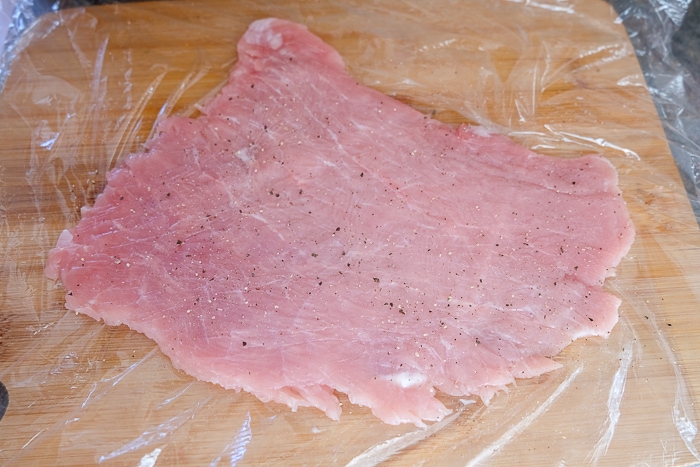
Salt and pepper both sides of the pork chop, then set it aside and repeat the steps with the other pieces of meat.
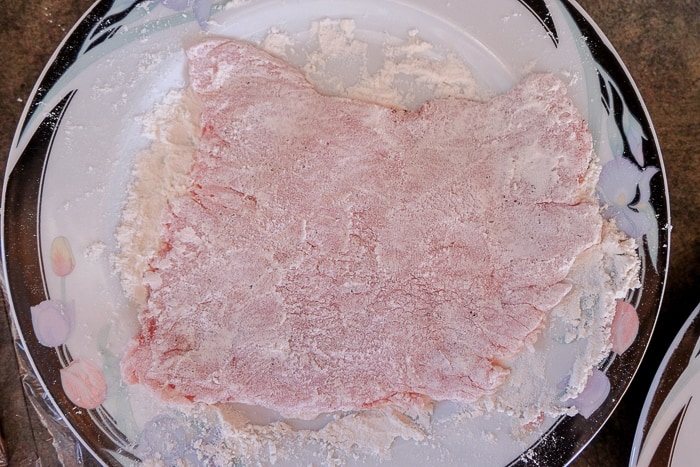
Once all the pieces of meat have been pounded and salted/peppered, it’s time for the breadcrumb coating.
First, place one pounded pork chop onto the plate with the flour and press down slightly. Turn it over so that the other side also gets covered in some flour.
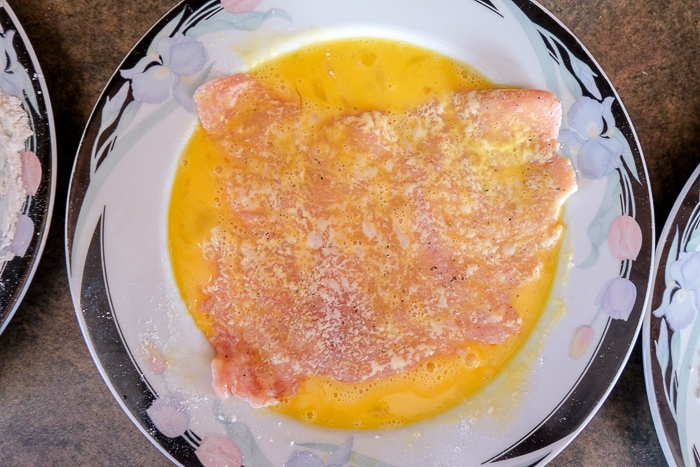
Then, lift it up and place the piece of meat on the plate with the whisked eggs. Again, flip it over so the other side gets covered as well.
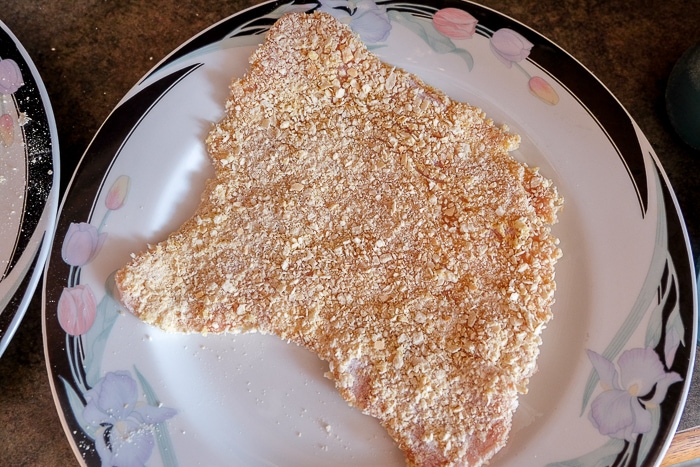
Lift the piece of meat, let the excess egg drip off, then transfer the piece of meat to the plate with the breadcrumbs.
Press down slightly, then turn it over and press down again. Make sure the whole piece of meat is covered in breadcrumbs.
Then set the breaded meat aside onto another plate. Repeat the flour-egg-breadcrumbs process with the rest of the meat.
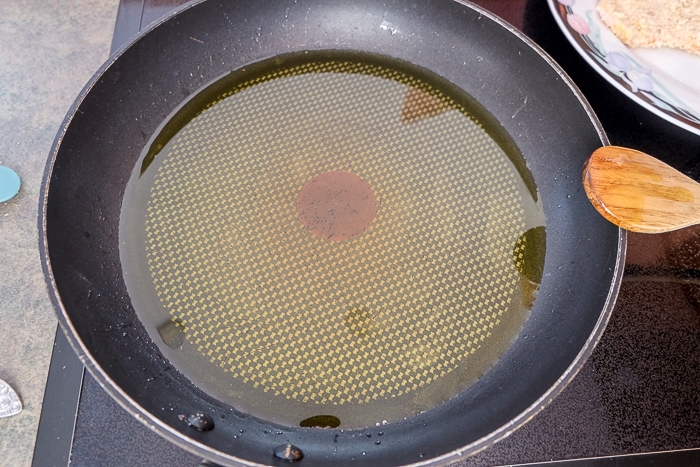
Heat oil, lard, or shortening in a large frying pan.
Test that the oil is hot enough by placing a wooden spoon into the oil. If there are small bubbles forming around the spoon, it is hot enough.
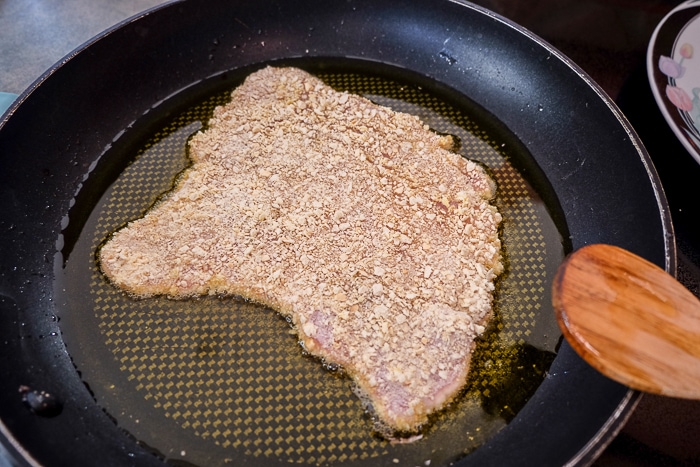
Now, place the pieces of meat into the pan. Depending on the size of your pan and your meat, you might have to do this in two or more rounds.
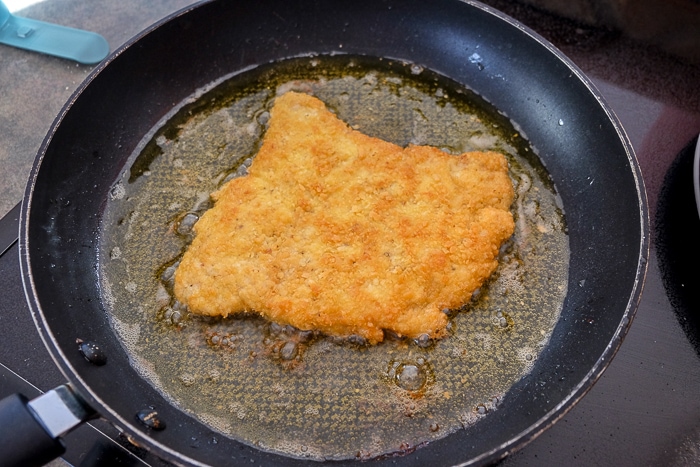
Fry the meat on medium heat for around 3-4 minutes, then carefully flip it over without breaking the breadcrumb coating.
We use a flipper but you can use tongs if you are careful. Fry for another 3-4 minutes until fully cooked.
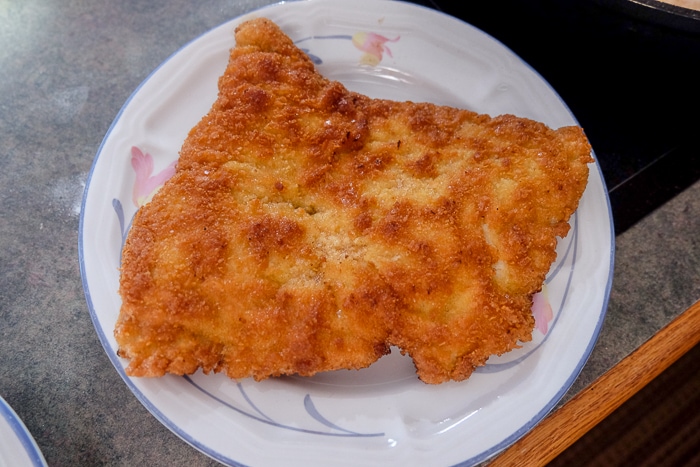
Then transfer the Schnitzel to a plate and fry the rest of the meat.
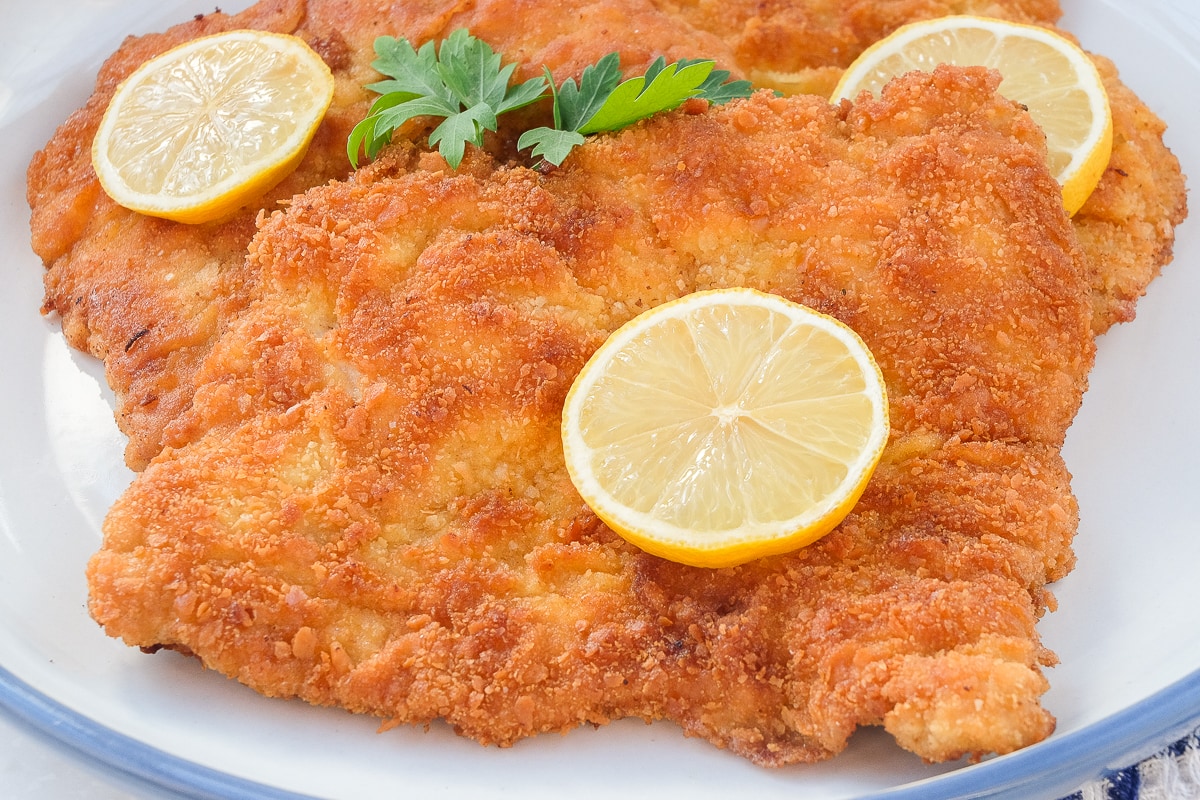
Serve the Schnitzel with some slices or wedges of lemon. Popular side dishes for schnitzel are classic French fries, German fried potatoes, or potato salad.
You can also use this schnitzel recipe as the base to make a delicious Schnitzel sandwich and for the schnitzel used in Jägerschnitzel (schnitzel with a creamy mushroom sauce)!
Storage Tips
Schnitzel tastes best fresh in our opinion so try eating it right out of the pan. However, you can store leftovers in a sealed bag, sealed container, or on a plate with cling wrap in the fridge.
You should consume any leftovers within 1-2 days.
To reheat these Schnitzel, the microwave is the most practical but you can also reheat it on a tray in the oven.
Many people also like to enjoy their schnitzel cold which is faster, easier, and also delicious!
FAQ
Schnitzel is thinly pounded meat – usually pork or veal – that is breaded and pan fried.
The difference lies in the type of meat used. A classic German schnitzel is made from thinly pounded pork while authentic Wiener Schnitzel is made from thinly pounded cut of veal.
German (pork) Schnitzel can be served with French fries, fried potatoes, and a number of potato salads. Wiener Schnitzel can be served with the same potato-based sides. In Vienna, Wiener Schnitzel is often enjoyed with a vinegar-based potato salad.
Related Recipes
For more great German recipes with meat, here are some classics to try out:
- Maultaschen – German meat stuffed pasta served in a delicious broth
- Königsberger Klopse – German meatballs with a caper-flavored sauce!
- Strammer Max – An open-faced German sandwich with ham and a fried egg
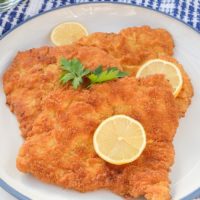
German Schnitzel
Ingredients
- 4 boneless pork chops, see notes
- salt to taste
- pepper to taste
- 1/4 cup all-purpose flour
- 2 large eggs
- 2/3 cup breadcrumbs, unseasoned
- 1/3 cup lard, shortening, or oil
- lemon for decoration
Instructions
- First, prepare your workstation by getting three large plates with higher sides. Put the flour on the first plate, crack the eggs and whisk them with a fork until uniform in color on the second plate, and add the breadcrumbs to the third plate.
- If there is excess fat on the meat, trim it.
- Place one pork chop between two pieces of cling wrap (or put it in a freezer bag) and pound it with the flat side of a meat hammer until thin. You’ll be surprised how large relatively small pieces of meat can get. At the same time, be careful since you don’t want to pound holes into your meat.
- Add salt and pepper to both sides of the pork chop, then set it aside. Pound and salt/pepper the rest of the meat.
- Take one piece of meat, place it onto the plate with the flour and press down slightly. Turn it over so that the other side also gets covered in some flour. Lift it up and place it on the plate with the whisked eggs. Again, flip it over so the other side gets covered as well. Lift the piece of meat, let the excess egg drip off, then transfer the piece of meat to the plate with the breadcrumbs. Press down slightly, then turn it over and press down again. Make sure the whole piece of meat is covered in breadcrumbs. Then set the breaded meat aside onto another plate. Repeat the flour-egg-breadcrumbs process with the rest of the meat.
- Heat oil, lard, or shortening in a large frying pan. Once the oil is hot enough (test this by placing a wooden spoon into the oil – if there are small bubbles forming around the spoon, it is hot enough), place the pieces of meat into the pan. Depending on the size of your pan and your meat, you might have to do this in two or more rounds. Fry the meat on medium heat for around 3-4 minutes, then carefully flip it over without breaking the breadcrumb coating. We use a flipper but you can use tongs if you are careful. Fry for another 3-4 minutes until fully cooked. Then transfer the Schnitzel to a plate.
- Serve the Schnitzel with some pieces of lemon. Popular side dishes are classic French fries, German fried potatoes, or potato salad.
Notes
- Instead of pork, you can also use veal cutlets. If you use veal, you can call your Schnitzel a "Wiener Schnitzel" (Vienesse Schnitzel). If you use pork, the Schnitzel can only be called "Schnitzel Wiener Art" (Schnitzel Vienesse Style) – but the taste will be equally delicious as long as you pound your meat really thin.
- We would not recommend frying the Schnitzel in normal butter due to its relatively low smoke point. It’s easier if you use lard, vegetable shortening, or oil with a high smoke point (e.g. avocado oil).
- You can store leftovers in a sealed container in the fridge. Consume them within 1-2 days.
Nutrition
This nutritional information has been estimated by an online nutrition calculator. It should only be seen as a rough calculation and not a replacement for professional dietary advice.
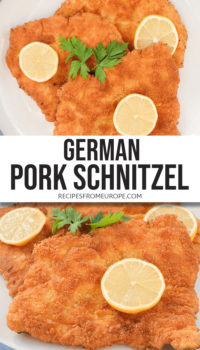
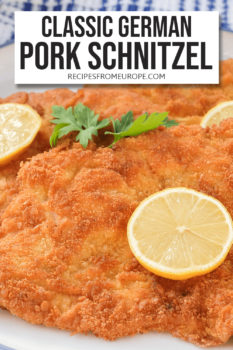

Excellent info with descriptions with explanations telling you what to avoid doing and why. Came out very good. Where I’m at the only breadcrumbs are Panko style so next time I will process them to make finer. I would say the best I’ve made.
We’re so happy to hear that you found our recipe and explanations helpful! You could also try making your own breadcrumbs by using stale crusty buns or a stale French baguette. Just cut it into small cubes and let them dry out on the counter. Then put them in a freezer bag and crush them with a rolling pin, meat hammer or similar.